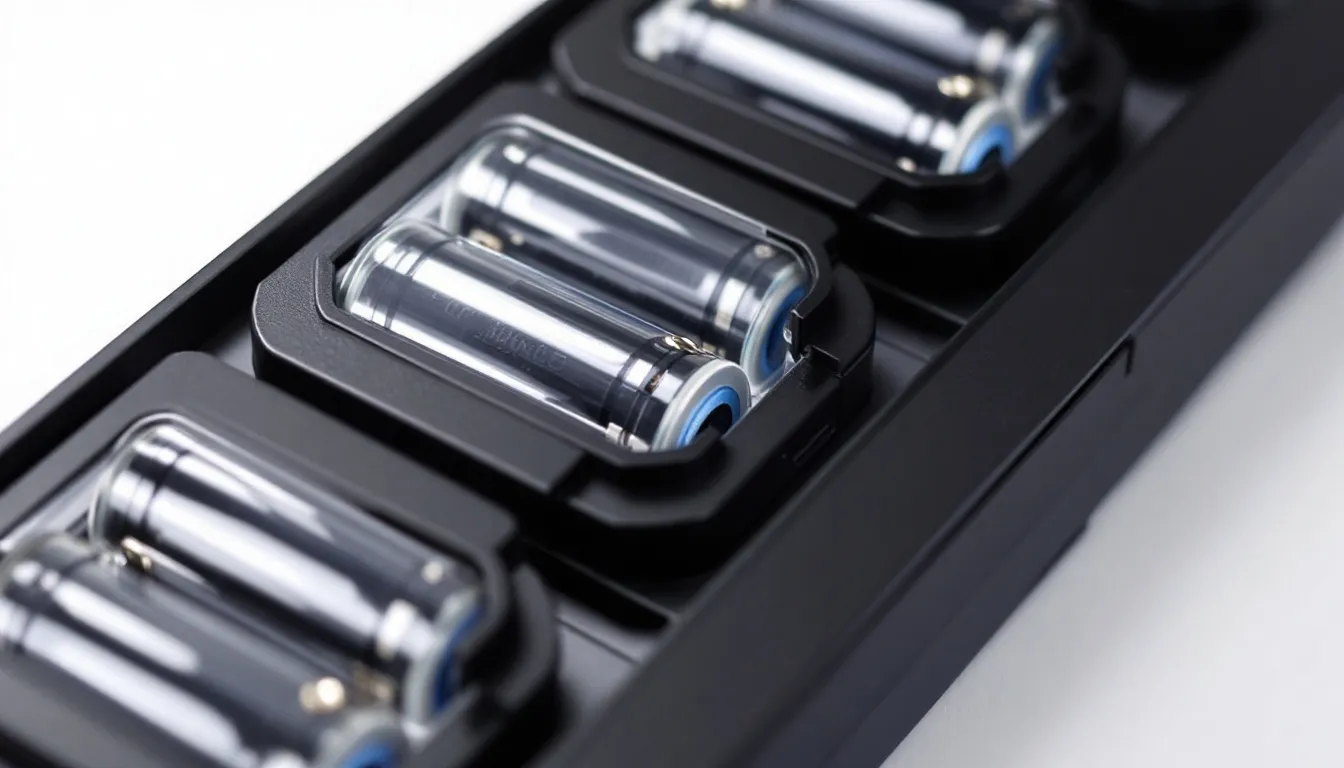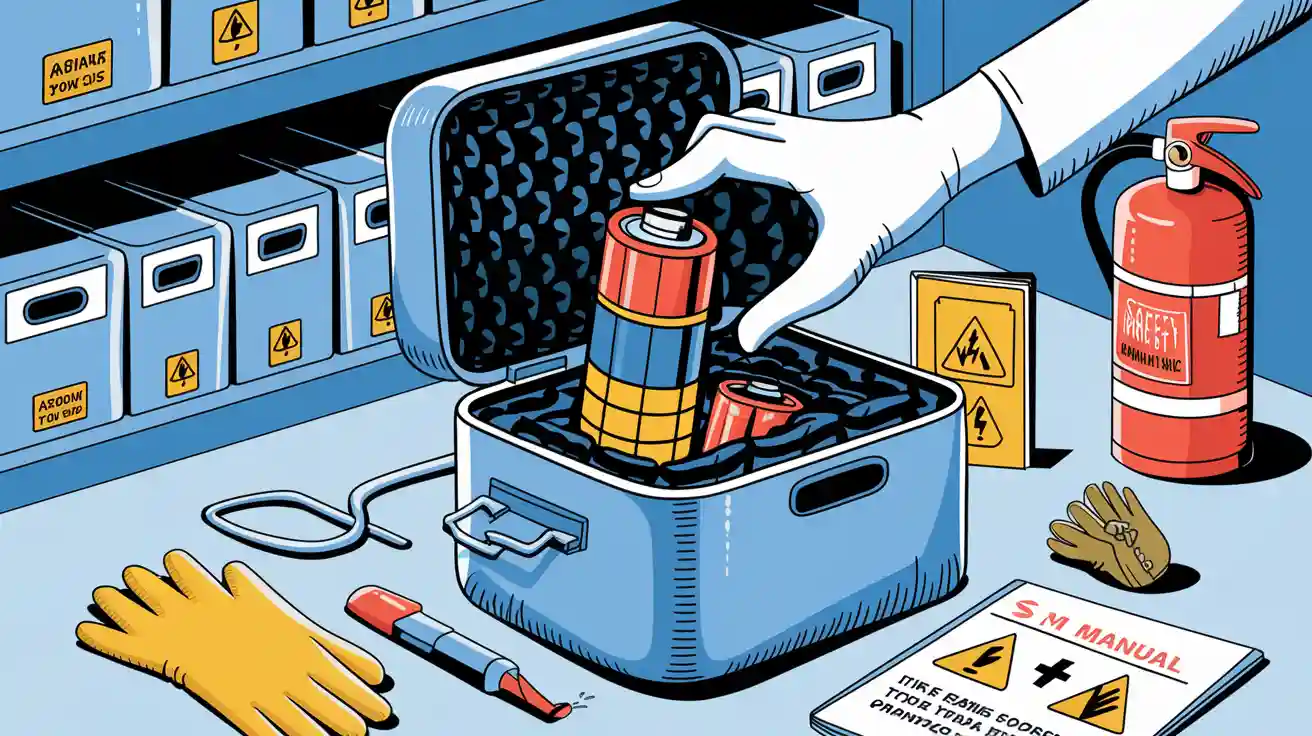Contents
Introduction to Robot Powering

Selecting the right battery for your robot is crucial for optimizing its performance and longevity, and understanding the right power supply can significantly enhance your robot’s efficiency and reliability. Battery voltage can drop under load, affecting performance during operation, so it is essential to choose a battery that can handle the demands of your robot’s tasks. Additionally, selecting the appropriate battery cell type, such as cylindrical or prismatic cells, is important for ensuring optimal robot performance.
Lithium ion batteries are widely used in robotics due to their high energy density and long lifespan, making them a popular choice for robot power. The appearance of polymer lithium-ion batteries, with their solid electrolyte, sleek and thinner design, makes them more desirable for modern electronic devices. Li-Poly batteries tend to be lighter than Li-Ion batteries while delivering equivalent power, which is advantageous for applications requiring reduced weight. It is also necessary to use the right connectors, such as Anderson SB connectors, to ensure compatibility and safety during operation.
The guide delves into the various types of batteries used in robotics, comparing their characteristics and suitability for different applications, including lithium ion battery characteristics and safety. Batteries can have significantly different specifications depending on their intended use, such as flight or robotics. NiMH batteries are favored for their low internal resistance and excellent power-to-weight ratio, making them a viable option for certain robotic applications. Additionally, the importance of a battery holder in ensuring safe and interchangeable use of batteries cannot be overstated, especially for consumer cells equipped with a spring in their battery holders.
Choosing the best battery for your robotic needs is essential for achieving optimal performance, safety, and reliability, and requires consideration of factors such as energy consumption and weight. Batteries with high energy density are ideal for robots that operate in limited spaces, as they provide the necessary power without compromising on compactness.
Types of Batteries

Lithium ion batteries, including li ion batteries, are a popular choice for robots due to their high energy density and long lifespan, and are often used in rechargeable batteries and battery packs. A blue consumer 18650 Li-Ion battery cell is particularly noted for its protective features and practical design attributes. These batteries consist of various types of battery cells, such as cylindrical and prismatic cells, which are crucial for the performance and safety of robotic devices. Cylindrical Li-Ion cells are a safer choice compared to pouch cells due to the additional protective metal layer, which enhances their durability and reliability. Flat ‘+’ terminals designed for welding multiple cells together in battery packs are another important feature, contrasting with raised terminals found in consumer cells.
Polymer batteries, such as lithium polymer batteries, offer improved safety and lighter weight, but may have a higher price and lower energy density. Li-Poly batteries are a subtype of Li-Ion batteries. However, Li-Ion batteries typically have a higher energy density compared to Li-Poly batteries, making them more suitable for applications requiring extended operational time.
Sealed lead acid (SLA) batteries are also used in robotics, particularly in applications where high energy density is not required, and offer a reliable and cost-effective solution. Proper chargers that are compatible with specific battery types are essential to ensure optimal performance and safety. SuperDroid robots carry various battery types, including sealed lead acid (SLA) batteries, for multiple power needs, showcasing their versatility in robotic applications. The shape of batteries, including cylindrical and prismatic forms, impacts their safety and performance, making them suitable for different devices like smartphones.
NiMH batteries are another option, offering a high capacity and long lifespan, but may have a lower energy density and higher self-discharge rate. The specific energy of NiMH batteries is notably inferior to that of lithium cells, which limits their use in applications requiring compact and lightweight power solutions.
Battery holders and standardized connectors, such as Anderson SB connectors, are also essential components of a robot’s power system, and must be carefully selected to ensure reliable operation. Electrical tape or heat shrink should cover connections for electrical safety, as exposed connections can lead to short circuits or other hazards.
Lithium Ion Battery Characteristics

Lithium ion batteries have a high energy density, making them ideal for applications where space is limited, and offer a long lifespan and low self-discharge rate. Their energy density also makes them suitable for demanding applications, such as military and aerospace, where performance and reliability are critical.
They are widely used in portable devices and electric vehicles, and are a popular choice for robot power due to their superior performance and reliability. Lithium ion batteries use a liquid electrolyte, while lithium-polymer batteries utilize a solid or polymer electrolyte, which impacts their performance and safety.
Lithium ion batteries require a battery management system to ensure safe and reliable operation, and must be charged and discharged within a specific voltage range. The nominal voltage of a lithium ion battery is typically around 3.7V, and the battery life is affected by factors such as temperature, charge cycles, and depth of discharge. The diameter of cylindrical battery cells is crucial for selecting appropriate components and understanding battery dimensions.
Lithium ion batteries are also available in a range of shapes and sizes, including cylindrical, prismatic, and pouch cells, each with its own advantages and disadvantages. Li-Ion batteries, which use a liquid electrolyte, are typically encased in a metal can to maintain structural integrity.
Li Ion Batteries and Safety

Li ion batteries require proper handling and storage to ensure safety, and must be protected from overcharge, over-discharge, and short circuits. The insulation of wiring is crucial in ensuring safe electrical connections, as it impacts performance and safety.
A battery protection circuit is essential to prevent damage and ensure reliable operation, and must be designed to meet the specific requirements of the application. Proper copper-to-copper contact between battery lead lugs and battery tabs is necessary to maintain reliability.
Li ion batteries are also subject to thermal runaway, which can cause a fire or explosion, and must be designed and tested to meet strict safety standards. When assembling battery connections, inserting contacts into Anderson SB connectors should be done carefully, following safety precautions to avoid any issues.
The use of lithium ion batteries in robots requires careful consideration of safety factors, including the risk of electrical shock, fire, and explosion. Li-Poly batteries lack a protection circuit, making them a riskier option compared to Li-Ion batteries.
Proper safety protocols and procedures must be followed when handling and storing lithium ion batteries, including the use of protective equipment and safe charging and discharging practices.
Battery Packs and Management

Battery packs are used to connect multiple cells together to provide a higher voltage and capacity, and require a battery management system to ensure safe and reliable operation. The battery management system must be designed to meet the specific requirements of the application, including the type of battery, voltage, and capacity. It is crucial to monitor battery performance and charging processes to ensure optimal performance and prevent overcharging. Managing battery use in robotic competitions is important to avoid equipment failures on the field, making reliable power sources essential.
Battery packs can be configured in a range of topologies, including series, parallel, and series-parallel, each with its own advantages and disadvantages. The choice of battery pack configuration depends on the specific requirements of the application, including the voltage, capacity, and power output. Managing stored energy is essential to prevent dangerous discharges and ensure safe handling. Robotics batteries designed for drones must accommodate high current demands for optimal performance.
Battery packs must also be designed to meet strict safety standards, including protection from overcharge, over-discharge, and short circuits. The volume of the battery is an important consideration when selecting batteries for various applications, as it impacts the spatial requirements and overall design. Customers can spend less time and money on replacements due to the cost-effectiveness of lithium-ion robotics batteries, allowing them to focus more on operational tasks.
Choosing the Right Battery
Choosing the right battery for your robot requires careful consideration of factors such as energy consumption, weight, and capacity, as well as the specific requirements of the application. Adjusting the camera focus for capturing detailed imagery during room scans carried out by robots is also crucial, as it ensures the accuracy of the spatial data collected. For example, a small robot designed for indoor use may require a lightweight lithium-ion battery with a capacity of 2000 mAh to ensure it can operate for several hours without recharging.
The type of battery, voltage, and capacity must be selected to meet the needs of the robot, and the battery must be compatible with the robot’s power system. It is also crucial to adhere to minimum size and length requirements for battery leads to ensure reliability and safety during operation.
The cost and availability of the battery must also be considered, as well as the environmental impact and recyclability. Additionally, following the guidelines provided by the manufacturer, particularly regarding voltage thresholds and recommended fasteners, is essential for ensuring the reliability and optimal performance of the battery system.
The right battery can provide superior performance, reliability, and safety, and considering the volume is essential for achieving optimal performance and longevity in a robot. Lithium-ion robotics batteries can last up to 10 years or more with proper maintenance.
A comparison of different battery types, including lithium ion, nickel-metal hydride, and sealed lead acid, can help to identify the best option for a specific application.
Ion Battery Applications
Lithium-ion batteries are a cornerstone of modern technology, powering a wide array of applications from robotics to consumer electronics. Their high energy density and long lifespan make them an ideal choice for devices that demand a reliable and efficient power source. In the realm of robotics, lithium-ion batteries provide the necessary energy to power robots, enabling them to perform complex tasks with precision and efficiency.
Electric vehicles, including cars and buses, also rely heavily on lithium-ion batteries. These batteries offer a clean and efficient source of energy, significantly reducing energy consumption and emissions compared to traditional fuel sources. In consumer electronics, lithium-ion batteries are ubiquitous, found in smartphones, laptops, and tablets, where their compact size and superior performance are highly valued.
Beyond these applications, lithium-ion batteries play a crucial role in renewable energy systems. They store excess energy generated by solar panels and wind turbines during the day, making it available for use at night or during periods of low generation. This capability not only enhances the reliability of renewable energy sources but also contributes to a more sustainable energy future.
The versatility and reliability of lithium-ion batteries make them indispensable in many modern technologies, providing numerous benefits such as reduced energy consumption, lower emissions, and improved performance. Their widespread use underscores their importance in our daily lives and the ongoing advancements in battery technology.
Battery Pack Configuration
A battery pack is essentially a collection of batteries connected together to form a single, cohesive power source. The configuration of a battery pack is tailored to meet the specific needs of the application it is intended to power. Battery packs can be arranged in series, parallel, or a combination of both, each configuration offering distinct advantages.
In a series configuration, batteries are connected end-to-end, with the positive terminal of one battery linked to the negative terminal of the next. This setup increases the overall voltage of the battery pack while maintaining the same capacity. Conversely, a parallel configuration involves connecting all the positive terminals together and all the negative terminals together, which increases the capacity while keeping the voltage constant.
The choice of configuration depends on the desired voltage, capacity, and power output required by the application. For instance, a high-voltage application might benefit from a series configuration, while a high-capacity application might be better suited to a parallel configuration. Some applications may even require a combination of both to achieve the necessary balance of voltage and capacity.
Safety is a paramount concern in battery pack design. Features such as overcharge protection and short-circuit protection are essential to prevent damage to both the batteries and the devices they power. The configuration of a battery pack can also influence its overall performance, including its energy density, power output, and lifespan. Therefore, careful consideration of the configuration is crucial to ensure optimal performance and safety.
Li Ion Battery Longevity
Li ion batteries have a long lifespan, typically ranging from 300 to 500 charge cycles, often providing the same amount of use depending on the type and quality of the battery. Using a log to track and review battery performance data after each driving session can provide valuable insights into battery health and readiness.
The lifespan of a li ion battery is affected by factors such as temperature, charge cycles, and depth of discharge, and can be extended by using properly rated tools and adhering to quality control practices for battery maintenance.
Li ion batteries must be stored in a cool, dry place, away from direct sunlight and moisture, and must be charged and discharged within a specific voltage range.
The use of a battery management system can help to extend the lifespan of a li ion battery, by preventing overcharge, over-discharge, and short circuits. The battery State of Charge should be kept over 50% for battery longevity.
Proper maintenance and storage of li ion batteries can help to ensure reliable operation and extend the lifespan of the battery. Lithium-ion batteries are manufactured using slim, flexible layers sealed in pouches, contributing to their lightweight and economical nature, which impacts their longevity.
Conclusion and Future Directions
In conclusion, lithium-ion batteries are a vital component of many modern technologies, from robotics and electric vehicles to consumer electronics. Their high energy density, long lifespan, and reliability make them an ideal power source for a wide range of applications. The configuration of a battery pack plays a critical role in determining its overall performance and safety, making it an essential consideration in battery design.
As technology continues to advance, we can anticipate further improvements in lithium-ion battery technology. Future developments may include enhanced energy density, longer lifespans, and reduced costs, driven by innovations such as solid-state electrolytes and more efficient charging and discharging methods. These advancements will not only improve the performance of existing applications but also pave the way for new technologies and uses.
The widespread adoption of lithium-ion batteries offers numerous benefits, including reduced energy consumption, lower emissions, and improved performance. However, challenges such as the risk of overheating, potential explosions, and environmental concerns must be addressed to ensure safe and sustainable use.
Overall, lithium-ion batteries are indispensable in enabling many modern technologies. Their continued development and improvement will be crucial in meeting the energy needs of the future, driving progress in various fields and contributing to a more sustainable and efficient world.





